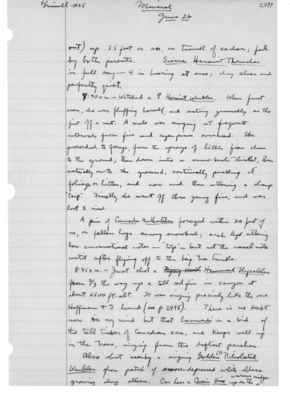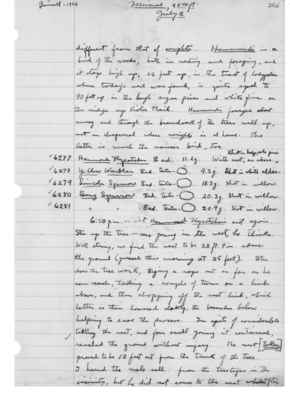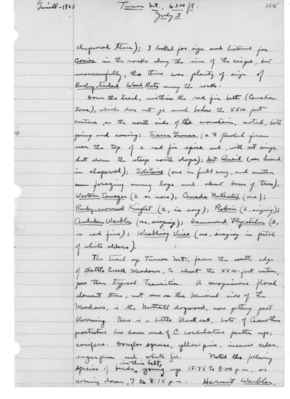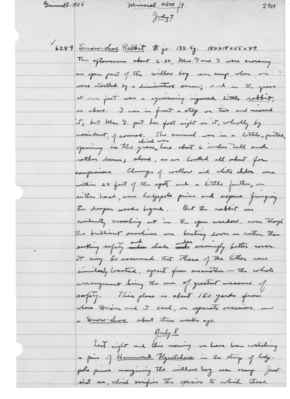Pages That Mention white alder
1925: Joseph Grinnell's field notes
S2 Page 43
Collector: Grinnell - 1925 Location: Mineral Date: June 26 Page Number: 2497
out) up 35 feet or so, on trunk of cedar; fed by both parents. Sierra Hermit Thrushes in full song - 4 in hearing at once, day clear and perfectly quiet.
7:40 a.m. - Watched a [female symbol] Hermit Warbler. When first seen, she was fluffing herself, and attacking generally as tho just off a nest. A male was singing at frequent intervals from fir and sugar pines overhead. She proceeded to forage, from the sprays of little fir close to the ground; then down into a snow-bush thicket, then actually on to the ground, continually picking at foliage or litter, and now and then uttering a sharp "tsip." Finally she went off thru young firs, and was lost to view.
A pair of Canada Nuthatches foraged within 20 feet of us, on fallen logs among snowbush; each kept uttering low conversational notes "Tiys" - but not the nasal note until after flying off to the big tree trunks.
8:45 a.m. - Just shot a Pygmy Nuth Hammond Flycatcher from 2/3 the way up a all red fir in canyon at about 6500 ft. alt. It was singing precisely like the one Hoffmann & I heard (see p. 2495). There is no doubt now in my mind but that hammondi is a bird of the tall timber of Canadian zone, and keeps well up in trees, singing from the loftiest perches.
Also shot a singing Golden ^(?) Pileolated Warbler from batch of snow-depressed white alders growing along the stream. Can hear a Cassin Vireo up on the ^warmer ridge.
S2 Page 55
Collector: Grinnell - 1925 Location: Mineral Date: June 28 Page Number: 2508
poising, motionless, at times against the stiff west wind. Mrs. G. found a family of Golden crowned Kinglets in a group of young firs near camp - adults and 4 young, fully grown. I had a clear view of the two of the young - white line over eye, contrasted against dusky or blackish top of head.
June 29 8 a.m. - Traill Flycatcher's nest: in bog, chiefly grown to willow, but some white alder; located out in jungle, alongside of indistinct deer-trail; overtopped, well shaded, by lush green willow and older foliage; rim 1400 mm. above ground, nest insse^securely supported among cluster of upright small willow stems and emanating leaves. Taken (2/4)*, and [female symbol] parent shot.
Russet-backed Thrushes' nest: in same bog as last; rim 780 mm. above ground; situated in rather low willow clump, with larger (taller) clumps of willow and white alder about separated from one another by openings grown to lush grass and buttercup; a meadow stream runs 20 feet away. The green leafage above and all about the nest effectually conceals the nest until parted. The nest is supported on a slanting willow stem plus adjacent twigs and foliage. Taken (1/4)**, and [female symbol] parent taken; [male symbol] heard singing in vicinity mornings and evenings ever since we have been here. Mrs. G. found this nest. The site is almost directly between those of the two
S2 Page 62
Collector: Grinnell - 1925 Location: Mineral, 4800 ft. Date: July 2 Page Number: 2515
different from that of wrighti. Hammondi is a bird of the woods, both in nesting and foraging, and it stays high up; 25 feet up, in the tract of lodgepoles where today's nest was found, is quite equal to 90 feet up in the high sugar pines and white firs on the ridge up Viola Trail. Hammondi forages about among and through the branchwork of the trees well up, not in chaparral where wrighti is at home. The latter is much the noisier bird, too.
6277 Hammond Flycatcher [female symbol] ad. 11.2g. With nest, as above. ^Shot in lodgepole pine. 6278 Yellow Warbler [male symbol] ad. testes [testes illustration]. 9.2g. Shot in white alder. 6279 Lincoln Sparrow [male symbol] ad. testes [testes illustration]. 18.3g. Shot in willow. 6280 Song Sparrow [male symbol] ad. testes [testes illustration]. 20.3g. Shot in willow. 6281 [Song] [Sparrow] [male symbol] ad. testes [testes illustration]. 20.4g. Shot in willow.
6:50 p.m. - At Hammond Flycatcher's nest again. Stu up the tree - sees young in the nest, he thinks. With string, we find the nest to be 28 ft. 9 in. above the ground (guessed this morning at 25 feet). Stu does the tree work, tying a rope out as far as he can reach, taking a couple of turns on a limb above, and then chopping off the nest limb, which latter is then lowered slowly, the branches below helping to ease the process. In spite of considerable tilting the nest, and four small young it contained, reached the ground without injury. The nest [taken] proved to be 13 feet out from the trunk of the tree. I heard the male call from the treetops in the vicinity, but he did not come to the nest while after
S2 Page 65
Collector: Grinnell - 1925 Location: Turner Mt., 6300 ft. Date: July 3 Page Number: 2518
chaparral there); I looked for sign and listened for Conies in the rocks along the rim of the cirque, but unsuccessfully, tho there was plenty of sign of Bushy-Tailed Wood Rats among the rocks.
Down the trail, within the red fir belt (Canadian Zone), which does not go much below the 5500 foot contour, on the north side of the mountain, noted, both going and coming: Sierra Grouse (a [male symbol] flushed from near the top of a red fir spire and, with set wings, shot down the steep north slope); Mt. Quail (one heard in chaparral); Solitaire (one in full song, and another seen foraging among logs and about bases of trees); Western Tanager (2 or more); Canada Nuthatch (one); Ruby-crowned Kinglet (2, in song); Robin (2, singing); Audubon Warbler (one, singing); Hammond Flycatcher (2, in red firs); Warbling Vireo (one, singing in patch of white alders).
The trail up Turner Mt. from the south edge of Battle Creek Meadows, to about the 5500-foot contour, goes thru [sic] typical transition. A conspicuous floral element there, not seen on the Mineral side of the Meadows, is the Nuttall dogwood, now getting past blooming. There is a little black oak, lots of Ceanothus prostratus low down and of C. cordulatus farther up; conifers: Douglas spruce, yellow pine, incense cedar, sugar pine, and white fir. Noted the following species of birds ^in this belt, going up 12:45 to 3:00 p.m., or coming down, 7 to 8:15 p.m.: Hermit Warbler,
S2 Page 71
Collector: Grinnell - 1925 Location: Mineral, 4800 ft. Date: July 7 Page Number: 2524
6289 Snow-shoe rabbit [male symbol] ju. 132.5 g. 180x18x55x49.
This afternoon about 2:30, Mrs. G and I were crossing an open part of the willow bog near camp, when we were startled by a diminutive stream; and in the grass at our feet was a squirming injured little rabbit, as above. I was in front a step or two and missed it; but Mrs. G. put her foot right on it, wholly by accident, of course The animal was in a little, parted opening in the grass ^which was here about 6 inches tall and rather dense; alone, as we looked all about for companions. Clumps of willow and white alder were within 25 feet of the spot; and a little farther, on either hand (?), were lodgepole pines and aspens fringing the deeper woods beyond. But the rabbit was evidently crouching out in the open meadow, even though the brilliant sunshine was beating down - rather than seeking safety underand shade andunder seemingly better cover. It may be assumed that others of the litter were similarly located, apart from one another - the whole arrangement being the one of greatest measure of safety. This place is about 150 yards from where Dixon and I each, on separate occasions, saw a Snow-shoe about three weeks ago.
July 8 Last night and this morning we have been watching a pair of Hammond Flycatchers in the strips of lodge pole pines margining the willow bog near camp. Just shot one, which verifies the species to which these




